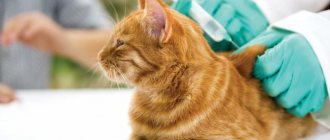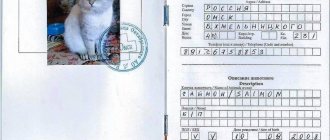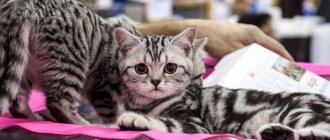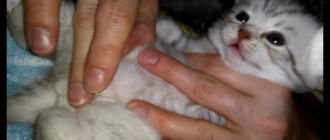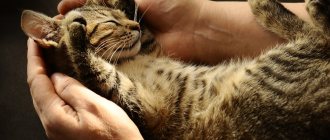What documents for a kitten must be given when purchasing it?
A purebred kitten must have documents confirming that it has the declared breed and the declared level of health. It is advisable that upon purchase you are given a veterinary passport, one copy of the contract and a metric/pedigree or their equivalent (for American systems). If they give you a metric, then you don’t need to ask for a pedigree, and, therefore, vice versa: the pedigree is given without a metric. Ideally, the breeder should give you one of these two documents, regardless of whether you are taking a kitten for castration or breeding.
ATTENTION!!!
Conscientious breeders do not sell kittens with documents for one amount, and without documents for another (cheaper). In any system, the litter is registered as a whole, and documents are issued for all kittens at the same time; a conscientious breeder cannot have kittens without documents in principle!
The preparation of documents for a litter in the club/system itself is quite inexpensive, but to obtain them you must strictly follow the rules of the system. Pedigree kittens with documents are expensive not because they have documents (papers), but because these “pieces of paper” guarantee the breed of the animal and its physical and mental health (to a certain extent). The documents also allow you to find a breeder, get advice, help, and even return the kitten and the money for it if problems arise.
Kitten veterinary passport
The veterinary passport indicates the name, gender, breed of the cat, its date of birth, the name of the owner and/or breeder. But the most important thing is that the passport must contain vaccination records with a special sticker, a veterinary clinic stamp and a doctor’s signature.
Veterinary passports come in different designs. The standard passport is blue with blue security inscriptions “pet”, but if they give you a passport of a different type, it’s okay. Different regions have different requirements, if anything happens, your veterinarian will make you a new correct passport and offer to keep the old one, just in case.
It is important to understand that every purebred kitten must have a veterinary passport, but it does not in any way confirm its breed, since it is filled out by a veterinarian or breeder, and clubs and exhibition systems are authorized to guarantee the breed.
Metrica\kitten slip (“kitty”)
This is the kitten’s birth certificate, which is issued upon its activation in the club/system. The metric indicates the kitten's name, its breed, gender, color, date of birth; names and colors of the kitten's parents; name of the breeder, etc. The document must have the emblem of the system to which the kitten belongs.
Also, the metric of the European system must bear the seal of the club that issued it, and the signature of the responsible club functionary who activated the kittens, so that in the future it can be exchanged for a pedigree.
In American systems, based on the metric (slip), a kitten is registered and a pedigree is ordered at the central office.
A European breeder may refuse to give kittens for castration, but he is obliged to at least show it to you. And it’s better to ask her to give her back, the club still knows that the kitten is for castration and will not give you the pedigree just like that.
In American systems, such problems do not arise, since all breeding restrictions are indicated when registering a litter.
By chance, I had to deal with such a phenomenon in felinology as guest actuation of kittens. Questions immediately arose: who uses it and for what purposes?
To be clear, the process for registering litters in many organizations is simple and differs only in details. The owner of the cat registers the animal with the organization for breeding, then takes part in a cat show (to obtain access to breeding work), registers a cattery (from where litters of kittens will be released), takes a referral from the cat club for mating, draws up a Certificate of Mating of Breeding Animals, registers the mating, then the birth of the litter in the registry, then registers the litter in the organization (if there is a package of documents) and all standard and satisfactorily raised kittens are issued with metrics, with which the animals are sold (of course, with a veterinary passport). That's all the wisdom.
All rules of breeding work are set out in the Regulations on breeding work and should be on the organization’s website, in the public domain. Therefore, cat owners never have questions about the breeding scheme for purebred cats, what is possible and what is not stated in this document. An experienced felinologist and breed curator can also guide the breeder on all issues in felinology, which is why the owner of the animal needs a cat club.
In many felinological systems, mating of animals is allowed starting from the age of one year, this corresponds to the age of a person - 18 years. At this age, the cat’s internal and genital organs are already well developed, and the animal is ready to reproduce. The number of litters is strictly limited; no more than two litters from one cat are allowed per year. These simple rules must be in the Regulations on Breeding Work so that the cat owner understands and calculates breeding programs in the cattery.
You must understand that guest registration of a litter involves the release of kittens on the side, in another cat club. This means that the breeder wants to get an additional litter of kittens, and it is not a fact that without compromising the health of the cat herself. This kind of greed for profit is difficult for a loving animal owner to understand, so guest registration of kittens in fact turned out to be a way of working for breeders who take in the quantity of kittens, not the quality.
Abuse of an unfortunate animal that is in the hands of a greedy breeder is a very terrible thing!!! Therefore, in professional cat clubs of the RCA system, there has been a strict rule for many years - the breeder does not have the right to register catteries and register litters of kittens in other organizations. But in public cat clubs, membership in several organizations is allowed at the same time, and no one is surprised by guest registrations of litters. Only the animals themselves suffer from such a mess.
To justify their actions by being members of several organizations, breeders cite the argument that they want to show their animals at cat shows of various felinological systems. This is wonderful! Why then register your catteries in different systems? Of course, in order to be able to have a bunch of documents from different foreign systems for one litter, no one sees the kittens there anyway, or in order to disfigure the animals with additional guest matings and the registration of litters in other organizations.
In any case, cruelty to animals and deception of buyers will not lead to any good! Flayers and sadists have nothing to do in felinology; there is no need to give them loopholes and access to guest registrations of litters. We must understand and realize who benefits materially from this, who suffers, and who condones such phenomena in felinology.
Pedigree (“roduha”) of the kitten
The pedigree indicates several generations (3-5) of your kitten’s ancestors (their nicknames, colors and pedigree numbers). The pedigree must contain the emblem of the association (system), the name of the club, nursery, the name of the breeder and the name of the owner of the kitten, information about the kitten itself.
Be careful: in the pedigree, in the “owner” column, your name must be indicated, not the name of the breeder! To do this, you need to either obtain a pedigree yourself, or agree in advance with the breeder on its registration.
In the European system, the pedigree must have a number, the seal of the club and the signature of its leader. In American ones, only the number is indicated, since the pedigree is issued by the system.
If the kitten is to be castrated, then in the European system they may give you a pedigree without a number or with a “pet” stamp, or not issue it at all, but again it would be better to negotiate so that they give it.
If you yourself draw up a pedigree based on metrics in a club specified by the breeder, then you must request it before the kitten turns one year old. This applies only to European systems; in American systems, the owner can request a pedigree based on the breeder slip at any time if the cat has been registered in the system. In American systems, pedigrees are informational in nature, and the pedigree of a cat is confirmed by registering the litter and the cat itself in the system in accordance with its rules.
However, you will not need a pedigree if you do not engage in breeding.
What to feed kittens at 2-3 months
There are two main ways to feed British kittens:
- professional line of food for kittens up to 4 months
- specialized natural nutrition with vitamin supplements
Natural food is only suitable if you are at home all day or are away only for a short period of time and can provide the kittens with 6 meals a day of natural food. Be sure to control the amount of calcium in the feed and provide vitamins and minerals.
We invite you to read: First vaccinations for Scottish kittens
If you are at work all day, and you can only feed the kittens in the morning and evening, then your task is, firstly, to maintain the cat’s lactation for as long as possible so that she can feed them, and secondly, to always leave dry food, and secondly, third, get up earlier and go to bed later in order to have time to feed the kittens with wet food at least 3-4 times with an interval of 2.5-3 hours.
When feeding professional food, it is very important that the kittens eat dry food, since wet food alone will not be enough for them. You won't get up and feed them at night, will you? And always a full bowl of dry food will be an excellent source of energy for them. Some kittens already from the age of one month show an active interest in drying; they do not need to be taught to eat dry food, but others may not pay any attention to it at all.
Therefore, you will have to teach them to love dry food. First, we try to soak a little dry food; the baby may like the new soft consistency and next time, recognizing the familiar smell, he will begin to eat the no longer soaked food. If the soaking option is not suitable, then we mix three spoons of dry food with one spoon of canned food, which the kitten is already confidently eating.
If the kitten does not eat, then you can change the proportion by increasing the amount of your favorite canned food. Usually, having gotten used to eating dry food mixed with canned food, the kitten begins to eat clean dry food from a bowl. Don't forget to put in plenty of water; it should be available at all times. Already at 4 weeks, some kittens drink with pleasure, although they have not yet begun to eat themselves.
You need to take special food according to age. The Royal Canin company has food for kittens from 1 month of age - these are the smallest granules that are very convenient for your kitten. Then you can replace it with food from 4 months or take food from another company for kittens. By the way, an animal is recognized as a kitten under the age of 10 months. This must be remembered and British kittens up to 1 year old should be fed correctly, taking into account their high need for calories and nutrients.
Certificate of registration of the cat in the system
In American exhibition systems, the main document of a cat is a registration form, which indicates the registration number of the animal. This document certifies the cat’s membership in the relevant system, and, consequently, the right to receive titles and pedigrees for it at the central office of the organization, and to register the litters received from it.
In addition to the number, the form indicates the name of the cat, its breed, color, its parents, date of birth, name of the owner and breeder of the animal; the logo of the system and the signature of its secretary (facsimile).
In fact, the registration certificate is also the system's legal proof of cat ownership. Therefore, usually, such a certificate is issued to the new owners of the cat, after purchasing it from the breeder, based on the received metrics. If the breeder registered the cat before the sale, then he is required to issue another document - a transfer.
Transfer to own a cat
A transfer is a document confirming the transfer of a cat from one owner to another. It is not required if, when purchasing a kitten, a pedigree was not made or registration in the system was completed, and also if, when registering one of these documents, the name of the new owner was already known and entered in the appropriate columns.
A de jure transfer for owning a cat exists in all exhibition systems, but in practice in European systems they prefer to issue kitten buyers with birth certificates so that they independently draw up pedigrees for themselves, and there are no official transfer forms. In these systems, transfers are issued by clubs only in cases of urgent need or if the new owner (not mentioned in the pedigree) wishes to register the cat in American associations. In the latter, transfers are more popular, although breeders also try to do without them.
In addition, in some American systems it is possible to rent a cat for a certain period. That is, the cat becomes yours and in the documents for the rental period you are indicated everywhere as its owner and are fully responsible for it.
Veterinary certificate form No. 1
If a kitten comes to you from another region, it must have veterinary form (certificate) No. 1 (transportation permit). It indicates the name, gender and age of the kitten, its breed; Breeder's name; There is also a doctor’s signature and a clinic stamp. If there is no such certificate or it was not given to you, then it’s okay, but if there is one, it means that the breeder did everything correctly and according to the law.
ATTENTION! If a kitten does not have documents, then it is not considered a purebred! Participation in breeding without a pedigree is impossible!
0
Cats from the nursery - veterinary passport and pedigree
In order for a cat to participate in exhibitions, owners must provide:
- veterinary passport;
- pedigree of the cat (if the animal is purebred);
- certificate form No. 4, which should be issued 3 days before the start of the event at the clinic.
In order to obtain a document of origin of the animal, the owner should have the kitten's identification card with him. It contains information about the baby’s parents, as well as the breed. Upon reaching 6 months, the metric is exchanged for a pedigree; to do this, you will need to contact the club in which the mother cat was registered.
A pedigree document is issued after verification and if the kitten meets accepted standards. It will contain the following information:
- name, contact details of the club;
- full nickname;
- color and breed;
- gender of the animal;
- information about the mother cat and her parents, as well as titles;
- information about the father;
- date of issue of the pedigree.
A document for an adult animal must be purchased differently. The cat is taken for examination, where it is decided whether it belongs to the breed or not.



